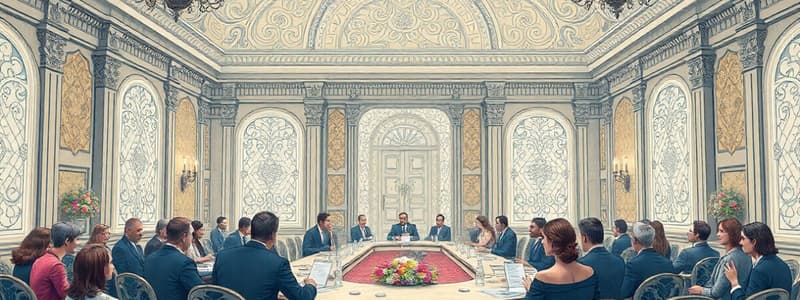Podcast
Questions and Answers
In what circumstances can the internal control body call a shareholders' meeting?
In what circumstances can the internal control body call a shareholders' meeting?
- When the administrative body fails to do so. (correct)
- When requested by a significant portion of the shareholders.
- When the company's bylaws require a meeting to be held.
- When the administrative body requests the internal control body to call the meeting.
- When carrying out its tasks, it discovers facts of significant seriousness requiring immediate action. (correct)
What is the deliberative quorum and its purpose?
What is the deliberative quorum and its purpose?
- The minimum percentage of shareholders required to attend the meeting for it to be considered valid.
- The minimum number of voting rights needed to pass a resolution during a second call of the meeting.
- The minimum number of shares needed present at the meeting for the meeting to be valid.
- The minimum proportion of shares that must vote in favor of a resolution for it to be approved. (correct)
- The number of shareholders required to approve a resolution through a system of successive calls.
Which of the following individuals or entities can attend a company's shareholders' meeting?
Which of the following individuals or entities can attend a company's shareholders' meeting?
- Only shareholders with voting rights.
- Members of the administrative body and the internal control body.
- Individuals who hold proxies on behalf of shareholders.
- All of the above. (correct)
- Only individuals who hold voting rights and members of the administrative and internal control bodies.
What limits are placed on proxy representation at shareholders' meetings for non-listed companies?
What limits are placed on proxy representation at shareholders' meetings for non-listed companies?
What is the purpose of the "system of successive calls" in shareholders' meetings?
What is the purpose of the "system of successive calls" in shareholders' meetings?
Which of the following is NOT a competency of the ordinary shareholders' meeting?
Which of the following is NOT a competency of the ordinary shareholders' meeting?
Which of the following statements accurately describes the relationship between the shareholders' meeting and the administrative body?
Which of the following statements accurately describes the relationship between the shareholders' meeting and the administrative body?
What is the key feature of the 'one-tier system' in relation to internal control?
What is the key feature of the 'one-tier system' in relation to internal control?
Which of the following is NOT a characteristic of the shareholders' meeting procedure?
Which of the following is NOT a characteristic of the shareholders' meeting procedure?
Which of the following scenarios would trigger the convening of an extraordinary shareholders' meeting?
Which of the following scenarios would trigger the convening of an extraordinary shareholders' meeting?
Flashcards
Shareholder Meeting
Shareholder Meeting
A body composed of shareholders that makes major company decisions and expresses the company's will.
Ordinary Shareholders' Meeting
Ordinary Shareholders' Meeting
A meeting that approves financial statements, appoints directors, and decides their remuneration.
Extraordinary Shareholders' Meeting
Extraordinary Shareholders' Meeting
A meeting that handles major changes like bylaws amendments and appointing liquidators.
Administrative Body
Administrative Body
Signup and view all the flashcards
Control Body
Control Body
Signup and view all the flashcards
Shareholders' Meeting Call
Shareholders' Meeting Call
Signup and view all the flashcards
Meeting Agenda
Meeting Agenda
Signup and view all the flashcards
Constitutive Quorum
Constitutive Quorum
Signup and view all the flashcards
Deliberative Quorum
Deliberative Quorum
Signup and view all the flashcards
Abuse of Majority Power
Abuse of Majority Power
Signup and view all the flashcards
Study Notes
Shareholder Meetings
- A company limited by shares (S.P.A.) has three internal bodies with defined powers.
- Shareholders' meeting: Makes major decisions, excluding management.
- Administrative body: Manages and represents the company, implementing shareholder resolutions.
- Internal control body: Monitors company administration.
Administration and Control Systems
- Traditional system: Administrative body and board of statutory auditors (default).
- Two-tier system: Supervisory body and management board.
- One-tier system: Board of directors and management control committee.
Shareholders' Meeting Procedures
- Who calls: Usually the administrative body.
- When: Mandatory once a year, or at shareholder request, or if directors fail or discover significant issues. Courts can also order a meeting.
- Where: Company headquarters.
- How? By giving notice (often called a "disclosure function").
- Plenary shareholders' meeting: All shareholders attend in one meeting.
- Who can attend: Shareholders with voting rights, members of administrative and control bodies, and others as allowed. Telecommunication attendance is common, including electronic voting.
- Listed companies: Allow shareholder suggestions on the agenda, and proposals for already scheduled topics. There are also quorum rules.
Ordinary and Extraordinary Meetings
- Ordinary meetings handle regular matters such as financial statements approval, director appointments, and determining director compensation.
- Extraordinary meetings deal with specific issues, including changes to the bylaws, and appointing or replacing liquidators.
- Types of meetings depend on the company and the specific issues.
Competence and Powers
- Ordinary shareholder meetings: Approve financial statements, appoint/remove directors, appoint/remove statutory auditors, determine liability.
- Extraordinary shareholder meetings: Modify bylaws, appoint/replace liquidators, other issues as defined by law.
- Some powers may be delegated to other administration bodies.
- General and special class shareholder meetings may have different rules, depending on different types of stock shares.
Shareholders’ Meeting Procedure (Cont’d)
- The meeting's agenda: Needs to be disclosed.
- Quorum: The specific percentage of shares capital required to be present for the meeting to be valid, and for decisions to pass
- Successive calls: Quorum required lowers for second calls.
- Meeting Functionaries: Chairman and secretary, and option for postponing meeting.
- Minutes: Must be recorded.
Representation at Shareholders' Meeting (Non-Listed Companies)
- Closed companies: Can use proxies (delegation) and may have limitations on representation
- Quantitative limits: Restrictions on individuals representing shareholders
Shareholders' Meeting Conflicts
- Abuse of majority. Conflicts of interest could occur between shareholders and the company. Also, shareholders not abiding by majority rule is an issue.
- Voting syndicates: Pre-arranged voting agreements might be made, also these are regulated.
Invalidity of Resolutions
- Annulability (voidable): Can be challenged by a party affected. Time limit to challenge exists.
- Nullity (void): More serious, can be deemed void by court, or by any party involved; generally more serious than an annulable decision.
Validity of Resolutions
- Certain situations, where company action is invalid, may be valid.
- This might be due to non-attendance, improper accounting of votes, or inaccurate minutes.
Additional Information
- Time limits exist for contesting resolutions, typically within 90 days of the resolution or from registration.
- Resolutions may be invalid if they violate laws or have impossible objectives.
- There's a concept of "sanatoria," where a faulty resolution becomes valid if corrected.
- Specific rules outline voting rights, quorums, and procedures, ensuring company stability.
Studying That Suits You
Use AI to generate personalized quizzes and flashcards to suit your learning preferences.




